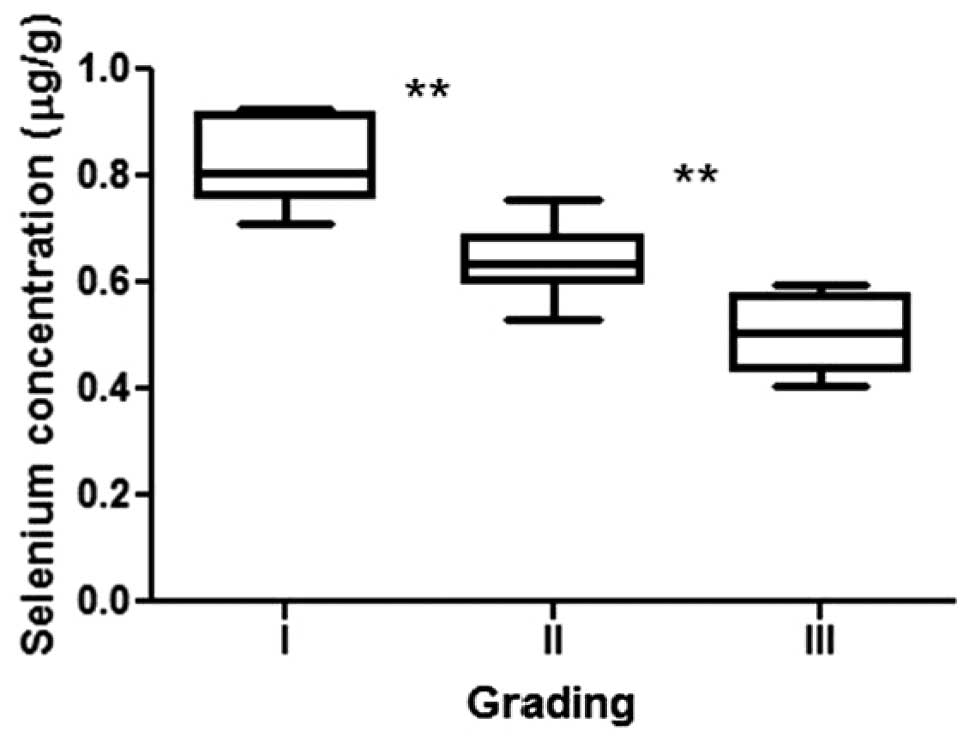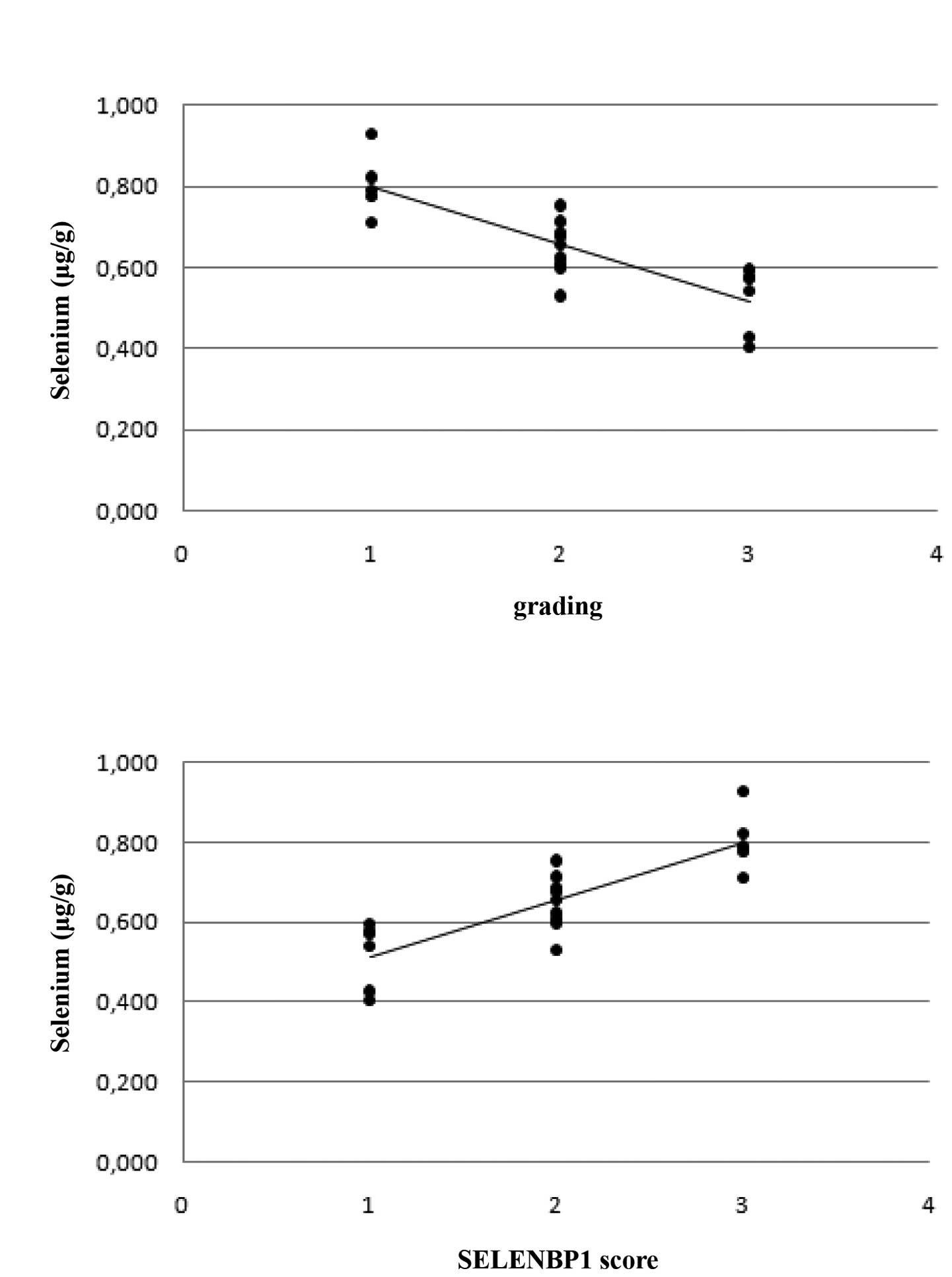|
1
|
Keshan Disease Research Group.
Epidemiologic studies on the ethiologic relationship of selenium
and Keshan disease. Chi Med. 92:477–482. 1979.PubMed/NCBI
|
|
2
|
Sagara Y, Tan S, Maher P and Schubert D:
Mechanisms of resistance to oxidative stress in Alzheimer’s disease
brain. Neurotoxicology. 19:339–345. 1998.
|
|
3
|
Clark LC, Combs GF Jr, Turnbull BW, et al:
Effects of Selenium supplementation for cancer prevention in
patients with carcinoma of the skin. JAMA. 276:1957–63. 1996.
View Article : Google Scholar
|
|
4
|
Rayman MP: Selenium in cancer prevention:
a review of the evidence and mechanism of action. Proc Nutr Soc.
64:527–542. 2005. View Article : Google Scholar : PubMed/NCBI
|
|
5
|
Peters U and Takata Y: Selenium and the
prevention of prostate and colorectal cancer. Mol Nutr Food Res.
52:1261–1262. 2008. View Article : Google Scholar : PubMed/NCBI
|
|
6
|
Trottier G, Boström PJ, Lawrentschuk N and
Fleshner NE: Nutraceuticals and prostate cancer prevention: a
current review. Nat Rev Urol. 7:21–30. 2009. View Article : Google Scholar : PubMed/NCBI
|
|
7
|
Yoo MH, Xu XM, Carlson BA, Patterson VN,
Gladyshev AD and Hatfield DL: Targeting thioredoxin reductase 1
reduction in cancer cells inhibits self-sufficient growth and DNA
replication. PLoS One. 2:11122007. View Article : Google Scholar : PubMed/NCBI
|
|
8
|
Lecomte E, Herberth B, Pirrollet P, et al:
Effect of alcohol comsumption on blood antioxidant nutrients and
oxidative stress indicators. Am J Clin Nutr. 60:255–261.
1994.PubMed/NCBI
|
|
9
|
Loguercio C, De Girolamo V, Federico A, et
al: Trace elements and chronic liver diseases. J Trace Elem Med
Biol. 11:158–161. 1997. View Article : Google Scholar : PubMed/NCBI
|
|
10
|
Guarini P, Stanzial AM, Olivieri O, et al:
Erythrocyte membrane lipids and serum selenium in post-viral and
alcoholic cirrhosis. Clin Chim Acta. 270:139–150. 1998. View Article : Google Scholar : PubMed/NCBI
|
|
11
|
Navarro-Alarcòn M and Lòpez-Martìnez MC:
Essentiality of selenium in the human body: relationship with
different diseases. Sci Total Environ. 249:347–371. 2000.PubMed/NCBI
|
|
12
|
Navarro-Alarcòn M, Lòpez-G de la Serrana
H, Pèrez-Valero V and Lòpez-Martìnez MC: Selenium concentrations in
serum of individuals with liver diseases (cirrhosis or hepatitis):
relationships with some nutritional and biochemical markers. The
Science of the total environment. 291:135–141. 2002.
|
|
13
|
Tashiro H, Kawamoto T, Okubo T and Koide
O: Variation in the distribution of trace elements in hepatoma.
Biol Trace Element Research. 95:49–63. 2003. View Article : Google Scholar : PubMed/NCBI
|
|
14
|
Casaril M, Corso F, Bassi A, et al:
Decreased activity of scavenger enzymes in human hepatocellular
carcinoma, but not in liver metastases. International Journal of
Clinical and Laboratory Research. 24:94–97. 2006. View Article : Google Scholar
|
|
15
|
Castello G, Scala S, Palmieri G, Curley SA
and Izzo F: HCV-related hepatocellular carcinoma: from chronic
inflammation to cancer. Clin Immunol. 134:237–50. 2010. View Article : Google Scholar : PubMed/NCBI
|
|
16
|
Fusco M, Girardi E, Piselli P, et al:
Epidemiology of viral hepatitis infections in an area of southern
Italy with high incidence rates of liver cancer. Eur J Cancer.
44:847–53. 2008. View Article : Google Scholar : PubMed/NCBI
|
|
17
|
Bansal MP, Mukhopadhyay T, Scott J, Cook
RG, Mukhopadhyay R and Medina D: DNA sequencing of a mouse liver
protein that binds selenium: implications for selenium’s mechanism
of action in cancer prevention. Carcinogenesis. 11:2071–2073.
1990.PubMed/NCBI
|
|
18
|
Chang PW, Tsui SK, Liew C, Lee CC, Waye MM
and Fung KP: Isolation, characterization, and chromosomal mapping
of a novel cDNA clone encoding human selenium binding protein. J
Cell Biochem. 64:217–224. 1997. View Article : Google Scholar
|
|
19
|
Raucci R, Colonna G, Guerriero E, et al:
Structural and functional studies of the human selenium binding
protein-1 and its involvment in hepatocellular carcinoma. Biochimi
et Biophys Acta. 1814:513–522. 2011. View Article : Google Scholar : PubMed/NCBI
|
|
20
|
Beilby JP, Prins AW and Swanson NR:
Determination of hepatic iron concentration in fresh and
paraffin-embedded tissue. Clinical Chemistry. 45:573–574.
1999.PubMed/NCBI
|
|
21
|
Everitt BS, Landau S and Leese M: Cluster
analysis. New York: Oxford Univ Press; 2001
|
|
22
|
Hartigan JA: Clustering algorithms. New
York: John Wiley and Sons Inc; 1975
|
|
23
|
Oldereid NB, Thomassen Y and Purvis K:
Selenium in human male reproductive organs. Human Reproduction.
13:2172–2176. 1998. View Article : Google Scholar : PubMed/NCBI
|
|
24
|
Takata Y, Morris JS, King IB, Kristal AR,
Lin DW and Peters U: Correlation between selenium concentrations
and glutathione peroxidise activity in serum and human prostate
tissue. The Prostate. 69:1635–1642. 2009. View Article : Google Scholar
|
|
25
|
Jeong JY, Wang Y and Sytkowski AJ: Human
selenium binding protein-1 (hSP56) interacts with VDU1 in a
selenium-dependent manner. BBRC. 379:583–588. 2009.PubMed/NCBI
|
|
26
|
Johnson P: Role of α-fetoprotein in the
diagnosis and management of hepatocellular carcinoma. Gastroenterol
and Hepatol. 14:S32–S36. 1999.
|
|
27
|
Nguyen M, Garcia R, Simpson P, Wright T
and Keeffe B: Racial differences in effectiveness of α-fetoprotein
for diagnosis of hepatocellular carcinoma in hepatitis C virus
cirrhosis. Hepatology. 6:410–417. 2002.
|
|
28
|
Kim W, Oe Lim S, Kim JS, et al: Comparison
of proteome between hepatitis B virus- and hepatitis C
virus-associated hepatocellular carcinoma. Clin Cancer Res.
9:5493–5500. 2003.PubMed/NCBI
|
|
29
|
Kuramitsu Y and Nakamura K: Current
progress in proteomic study of hepatitis C virus-related human
hepatocellular carcinoma. Expert Rev Proteomics. 2:589–601. 2005.
View Article : Google Scholar : PubMed/NCBI
|
|
30
|
Li C, Hong Y, Tan YX, et al: Accurate
qualitative and quantitative proteomic analysis of clinical
hepatocellular carcinoma using laser capture microdissection
coupled with isotope-coded affinity tag and two-dimensional liquid
chromatography mass spectrometry. Mol Cell Proteomics. 3:399–409.
2004. View Article : Google Scholar
|
|
31
|
Liang CR, Leow CK, Neo JC, et al: Proteome
analysis of human hepatocellular carcinoma tissues by
two-dimensional difference gel electrophoresis and mass
spectrometry. Proteomics. 5:2258–2271. 2005. View Article : Google Scholar
|
|
32
|
Lim SO, Park SJ, Kim W, et al: Proteome
analysis of hepatocellular carcinoma. BBRC. 291:1031–1037.
2002.PubMed/NCBI
|
|
33
|
Blanc JF, Lalanne C, Plomion C, et al:
Proteomic analysis of differentially expressed proteins in
hepatocellular carcinoma developed in patients with chronic viral
hepatitis C. J Proteomics. 5:3778–3789. 2005. View Article : Google Scholar
|
|
34
|
Kim J, Kim SH, Lee SU, et al: Proteome
analysis of human liver tumor tissue by two-dimensional gel
electrophoresis and matrix assisted laser
desorption/ionization-mass spectrometry for identification of
disease-related proteins. Electrophoresis. 23:4142–4156. 2002.
View Article : Google Scholar
|
|
35
|
Paradis V, Degos F, Dargere D, et al:
Identification of a new marker of hepatocellular carcinoma by serum
protein profiling of patients with chronic liver diseases.
Hepatology. 41:40–47. 2005. View Article : Google Scholar : PubMed/NCBI
|
|
36
|
Santamaría E, Muñoz J, Fernández-Irigoyen
J, et al: Molecular profiling of hepatocellular carcinoma in mice
with a chronic deficiency of hepatic S-adenosylmethionine:
relevance in human liver diseases. J Proteome Res. 5:944–953.
2006.
|
|
37
|
Kryukov GV, Castellano S, Novoselov SV, et
al: Characterization of mammalian selenoproteomes. Science.
300:1439–1443. 2003. View Article : Google Scholar : PubMed/NCBI
|
|
38
|
Porat A, Sagiv Y and Elazar Z: A 56-kDa
selenium-binding protein participates in intra-Golgi protein
transport. J Biol Chem. 275:14457–65. 2000. View Article : Google Scholar : PubMed/NCBI
|
|
39
|
Flemetakis E, Agalou A, Kavroulakis N, et
al: Lotus japonicus gene Ljsbp is highly conserved among
plants and animals and encodes a homologue to the mammalian
selenium-binding proteins. Mol Plant Microbe Interact. 15:313–22.
2002. View Article : Google Scholar
|
|
40
|
Darvesh AS and Bishayee A: Selenium in the
prevention and treatment of hepatocellular carcinoma. Anti Canc
Agents Med Chem. 10:338–345. 2010. View Article : Google Scholar : PubMed/NCBI
|












